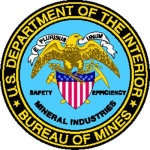- Branża: Mining
- Number of terms: 33118
- Number of blossaries: 0
- Company Profile:
The U.S. Bureau of Mines (USBM) was the primary United States Government agency conducting scientific research and disseminating information on the extraction, processing, use, and conservation of mineral resources.
Founded on May 16, 1910, through the Organic Act (Public Law 179), USBM's missions ...
A clay or claylike material with a high adsorptive capacity, consisting largely of the clay minerals montmorillonite and palygorskite. Used originally in England for whitening, degreasing, or fulling (shrinking and thickening by application of moisture) woolen fabrics; fuller's earth now is extensively used as an adsorbent in refining and decolorizing oils and fats; it is a natural bleaching agent. Its color ranges from light brown through yellow and white to light and dark green; it differs from ordinary clay by having a higher percentage of water and little or no plasticity, tending to break down into a muddy sediment in water. Fuller's earth probably forms as a residual deposit by decomposition of rock in place, as by devitrification of volcanic glass. The term is applied without reference to any particular chemical or mineral composition, texture, or origin.
Industry:Mining
A clay or claylike material with a high adsorptive capacity, consisting largely of the clay minerals montmorillonite and palygorskite. Used originally in England for whitening, degreasing, or fulling (shrinking and thickening by application of moisture) woolen fabrics; fuller's earth now is extensively used as an adsorbent in refining and decolorizing oils and fats; it is a natural bleaching agent. Its color ranges from light brown through yellow and white to light and dark green; it differs from ordinary clay by having a higher percentage of water and little or no plasticity, tending to break down into a muddy sediment in water. Fuller's earth probably forms as a residual deposit by decomposition of rock in place, as by devitrification of volcanic glass. The term is applied without reference to any particular chemical or mineral composition, texture, or origin.
Industry:Mining
A clay or earth that, either in its natural state or after chemical activation, has the capacity for adsorbing or removing coloring matter or grease from liquids (esp. oils).
Industry:Mining
A clay or earth that, either in its natural state or after chemical activation, has the capacity for adsorbing or removing coloring matter or grease from liquids (esp. oils).
Industry:Mining
A clay pottery product that is widely employed to resist acids and alkalies. It is used for utensils, pipes, stopcocks, pumps, etc.; sp gr, 2.2; hardness, scleroscope 100. Stoneware is made from special clays free from lime and iron, low in sand content, with low temperatures, and having sufficient plasticity to permit turning on a potter's wheel.
Industry:Mining
A clay pottery product that is widely employed to resist acids and alkalies. It is used for utensils, pipes, stopcocks, pumps, etc.; sp gr, 2.2; hardness, scleroscope 100. Stoneware is made from special clays free from lime and iron, low in sand content, with low temperatures, and having sufficient plasticity to permit turning on a potter's wheel.
Industry:Mining
A clay such as kaolin that is free from organic matter and so does not give rise to bubbles if used in a vitreous enamel; such clays are used in enamels when good gloss and clear colors are required.
Industry:Mining
A clay suitable for manufacture of stoneware (ceramic ware fired to a hard, dense condition and with an absorption of less than 5%); used for items such as crocks, jugs, and jars. It possesses good plasticity, fusible minerals, and a long firing range.
Industry:Mining
A clay suitable for use in the manufacture of porcelain; specif. kaolin.
Industry:Mining
